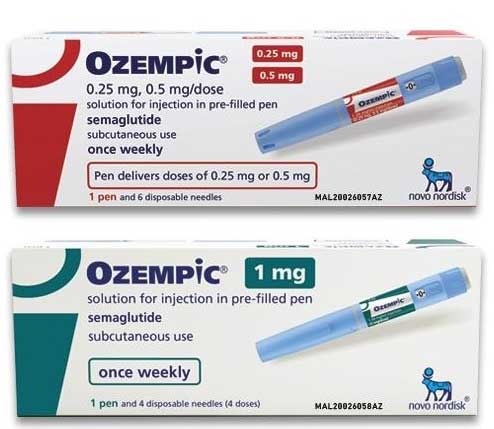Description

Ozempic (semaglutide) is an injectable medication that is used with diet and exercise to treat adults with type 2 diabetes. It is also used to decrease the risk of major cardiovascular events like heart attack, stroke, or death in adults who have been diagnosed with type 2 diabetes and heart disease.
Although Ozempic may help you with weight loss, it is not indicated for weight loss.
Directions
Ozempic is available in single-patient-use pens:
| Fact Table |
| Formula |
C187H291N45O59 |
| License |
EU EMA, US FDA |
| Bioavailability |
89% |
| Legal status |
Rx-Only |
| Chemical Name |
Semaglutide |
| Elimination half-life |
7 days |
| Dosage (Strength) |
2mg (0.25/0.5mg per dose), 4mg (1 mg per dose) (Pen Injector) |
| Pregnancy |
Should not be used |
| Brands |
Ozempic |
| Protein binding |
More than 99% |
| PubChem CID |
56843331 |
| MedlinePlus |
a618008 |
| ChEBI |
167574 |
| ATC code |
A10BJ06 |
| DrugBank |
DB13928 |
| KEGG |
D10025 |
| Routes of administration |
Subcutaneous |
- 2 mg/1.5 mL (1.34 mg/mL): provides 0.25 mg, 0.5 mg, or 1 mg per injection
- 4 mg/3 mL(1.34 mg/mL): provides 1 mg per injection
Follow the instructions that come with your prescription. If you have questions about how to administer Ozempic, ask your doctor or pharmacist.
Initial dose: 0.25 mg injected subcutaneously into the abdomen, thigh, or upper arm once weekly, with or without food. After 4 weeks, your doctor may increase your dose to 0.5 mg once weekly. Your doctor may decide to increase your dose to 1 mg once weekly depending on how well you tolerate the medication.
Injection sites should be rotated each week.
If you miss your dose, you may administer your dose within 5 days of the missed dose.
You can store unused Ozempic pens without an attached needle in the refrigerator until the expiration date. You can store used Ozempic pens without an attached needle at room temperature or in the refrigerator until the expiration date or for 56 days, whichever occurs first. Do not store Ozempic pens in the freezer.
A new needle should be used for each injection. Do not share an Ozempic pen, even if a new needle is attached. Place used needles in a sharps disposal container after each injection.
Ingredients
The active ingredient in Ozempic is semaglutide.
Contraindications
You should not use Ozempic if you or a family member has had a type of thyroid cancer called medullary thyroid carcinoma.
You should not use Ozempic if you have Multiple Endocrine Neoplasia syndrome type 2.
You should not use Ozempic if you are allergic to semaglutide or any of the ingredients or excipients in Ozempic.
Cautions
|
WARNING: RISK OF THYROID C-CELL TUMORS
See full prescribing information for complete boxed warning.
- In rodents, semaglutide causes thyroid C-cell tumors. It is unknown whether OZEMPIC® causes thyroid C-cell tumors, including medullary thyroid carcinoma (MTC), in humans as the human relevance of semaglutide-induced rodent thyroid C-cell tumors has not been determined.
- OZEMPIC® is contraindicated in patients with a personal or family history of MTC or in patients with Multiple Endocrine Neoplasia syndrome type 2 (MEN 2). Counsel patients regarding the potential risk of MTC and symptoms of thyroid tumors.
|
- Before you start using Ozempic, tell your doctor:
- About all the medications you take. These include prescription, nonprescription, vitamins, and herbal supplements.
- About your allergies.
- About your health conditions.
- If you are pregnant or plan to become pregnant.
- If you are breastfeeding or plan to breastfeed.
- Ozempic can cause pancreatitis. Seek medical care immediately if you experience continuous severe stomach pain that may radiate to the back, with or without vomiting.
- Ozempic can cause complications of diabetic retinopathy. Tell your doctor right away if you experience vision problems or changes.
- Ozempic can cause low blood sugar levels if used with an insulin secretagogue or insulin. Monitor your blood sugar and treat low blood sugar levels as your doctor has instructed.
- Ozempic can cause kidney problems.
- Ozempic can cause severe allergic reactions. Seek medical care immediately if you have trouble breathing, trouble swallowing, swelling of your face, lips, or tongue, a serious rash, itching, fainting, or a very fast heartbeat.
Side Effects
Like with any medication, Ozempic can cause side effects. The most common include constipation, diarrhea, nausea, vomiting, and stomach pain. These are not all the possible side effects that can occur with the use of Ozempic. Contact your doctor right away if you develop side effects that bother you or won't go away.
Click the links below to jump to the section of the FAQ you want to learn more about.
- Am I a Good Candidate to Switch to Ozempic?
- How Does Ozempic Work?
- How Do I Take Ozempic?
- Is Ozempic Proven to Lower A1C?
- Does Ozempic Help with Weight Loss for Type 2 Diabetes?
- How Much Does Ozempic Cost?
- What Sort of Diet Changes and Exercise are Required with Ozempic?
-
Am I a Good Candidate to Switch to Ozempic?
Ozempic is effective for lowering blood sugar and A1C hemoglobin test scores for most people. Type 2 diabetics that are more at risk of cardiovascular failure, heart attack, or stroke because of their diabetes are ideal candidates to switch to Ozempic.
Better diabetes management with Ozempic is dependent on diet and exercise level changes to go along with using Semaglutide. Ozempic is not for weight loss, but some users may see better results from the increased physical activity levels that are a part of treatment with this medication.
Meeting with your physician is the first step to seeing if Ozempic is a better choices as your diabetes medication.
-
How Does Ozempic Work?
Ozempic is a non-insulin diabetes medication that work with the body's natural ability to lower blood sugar and get A1c scored down below the standard 7% threshold. It is designed to begin working when your blood sugar rises, and it promotes the pancreas releasing more insulin when blood sugar levels are up.
Ozempic also prevents the liver from producing and releasing higher levels of glucose. The last part of how Ozempic works is that it slows down food leaving the stomach.
-
How Do I Take Ozempic?
Ozempic is a once-weekly diabetes medication delivered with the Ozempic pen. The injection is administered under the skin (subcutaneously) of the stomach (abdomen, thigh, or upper arm).
These are the only three administration sites. Injection should not be made into a muscle (intramuscularly) or into a vein (intravenously).
-
Is Ozempic Proven to Lower A1C?
Ozempic users commonly see better results in their A1C test scores, but results will vary for people based on different factors. It is important to follow your diabetes treatment regimen exactly as it is laid out for by your doctor, and Ozempic users need to incorporate diet and exercise changes to see best results.
- Of adults with an average starting A1C of 8.1%, 66% of those taking 0.5mg Ozempic reached an A1C of 7% or less
- 73% of those taking 1mg and 40% of people taking 100mg Januvia for Type 2 diabetes did the same - getting to an A1C of 7% or lower
-
Does Ozempic Help with Weight Loss for Type 2 Diabetes?
It is important to understand that Ozempic is not indicated for weight loss. Increased weight loss may be benefit for some people using Ozempic, and especially those who adhere to the diet and exercise part of using this medication. Keep in mind that some study participants using Ozempic experienced weight gain, although this is uncommon.
For people with an average starting weight of 197 pounds
- 0.5mg Ozempic users lost an average of 9 pounds
- 1mg Ozempic users lost an average of 12 pounds
- 100mg Januvia users lost an average of 4 pounds
Based on a 1-year study
-
How Much Does Ozempic Cost?
Your Ozempic price will depend on the pharmacy and whether you are filling a prescription for the 0.5mg or 1mg Ozempic pen. Many people in North America will be able to buy diabetic medication with a co-pay arrangement through their health benefits. US residents may want to consider applying for the Ozempic savings card made available by Novo Nordisk.
You also may be able to buy Ozempic for less when you order medication online from Canada Pharmacy.
-
What Sort of Diet Changes and Exercise are Required with Ozempic?
Best results from Ozempic for Type 2 diabetes are seen in users who eat a healthier diet with lower glycemic loads per meal and significant reductions in sugar intake via diet. Increased exercise / physical activity levels should be discussed with your doctor before starting on a Type 2 diabetes treatment medication. For most people 30 minutes of upbeat cardiovascular exercise (anything that gets your heart rate up and makes you break a sweat) 3 times a week is a good baseline to start at.
If you are beginning physical exercise for the first time it is important to go slow and steady in the beginning, and this is true for people of all ages.
References:
- Ozempic semaglutide injection. Plainsboro, NJ: Novo Nordisk Inc.; 2021.
- Once-weekly Ozempic semaglutide injection. Important Safety Information. https://www.ozempic.com. Accessed March 14, 2022.
About Dr. Savannah Muncy (Page Author)
Dr. Muncy (PharmD) studied science and education as an undergraduate before attending the Appalachian College of Pharmacy where she completed her PharmD in three years. She is currently using her pharmacy and healthcare expertise to write medical content for clients all around the world. She is focused on delivering the most current, accurate, and engaging information to healthcare professionals and patients. Read More....
IMPORTANT NOTE:
The above information is intended to increase awareness of health information and does not suggest treatment or diagnosis. This information is not a substitute for individual medical attention and should not be construed to indicate that use of the drug is safe, appropriate, or effective for you. See your health care professional for medical advice and treatment.
Product Code : 13677

